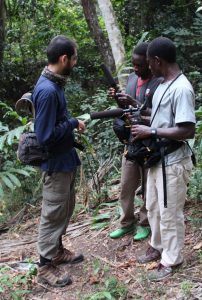Michael Wilson in Smithsonian Magazine:
 To investigate chimp communication, my colleagues and I follow chimpanzees through the forest as they go about their lives. We carry a hand-held “shotgun” microphone and a digital recorder, waiting for them to call.
To investigate chimp communication, my colleagues and I follow chimpanzees through the forest as they go about their lives. We carry a hand-held “shotgun” microphone and a digital recorder, waiting for them to call.
Usually we pick a particular chimp to follow each day, trying to get equal numbers of calls per individual. In addition to recording new calls, we’ve been working to build an archive of recordings from other researchers, going back to the 1970s. The archive currently contains over 71 hours of recordings.
Snake alarm calls are intriguing, but because chimps don’t encounter large snakes very often, it is hard to do a systematic study of them. (Cathy Crockford and colleagues have done some interesting experiments, though, playing back recordings of these calls to see how chimpanzees respond and presenting them with model snakes). One thing chimpanzees do every single day, though, is eat. Chimpanzees spend most of their time looking for food and eating it. And when they find food, they often give a particular kind of call: the rough-grunt.
More here.
